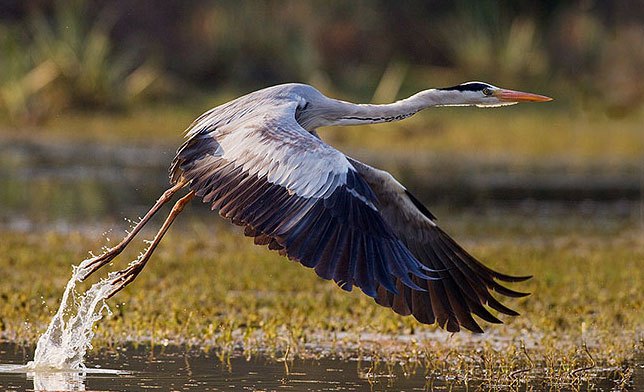Desert National Park is one of the major national parks, having an area of 3162 km². It is a brilliant sample of the ecosystem of the desert silt form about 20% of the Park. The main land form comprises of rugged stalwarts and dense brackish lake ends, inter modal regions and static mounds. Desert National park Jaisalmer Rajasthan is one of fantastic sanctuary all over India.
Even with a delicate ecological unit there exist a plenty of bird life. The area is a shelter for migratory and inhabitant fowls of the desert, a lots of eagles, harriers, falcons, buzzards, kestrel and vultures. Short-toed Eagles, Tawny Eagles, Spotted Eagles, Laggar Falcons and kestrels are the very common amongst these. Sand grouse are marked close to the trivial pools or ponds. The threatened Great Indian Bustard is a superb birdie existed in comparatively reasonable quantities.
It travels nearby in diverse time of year. The most appropriate time to stopover the region is in the middle of November and January. The Park has a group of remnants of faunas and floras of 180 million years ancient. Some remnants of Dinosaurs of 6 million years ancient have been originated in the area.
Best Time To Visit- Detailed Information
The best time to stopover National park Jaisalmer Rajasthan is between the months of October to March, even though the town remains busy with travelers all through the year. Yet, in mid summers there are probabilities one might get affected with heat blow.
Distance From – National Park
The distance of the park from jaisalmer is around forty kilometers. The park is located at a distance of 300 kilometers from the airport of Jodhpur.
How To Reach There
By Airways
However Jaisalmer is not straight linked to Airways, Jodhpur airport which is 300 Km away, is linked to all the main cities of India through government possessed as well as reserved air company. From Jodhpur one can take rental Cabs or a train trip as per desire and preference.
Things To Do In – National Park
Jeep Trip allows travelers to discover a broader area of the park in comparatively little time. Likewise, it is extremely fascinating to see the inclusive variety of plants and animals from the jeep.
Camp out is possibly the finest way to relish the fauna of the park. Though, travelers must thought the delicate flora of the park and therefore abstain from affecting any kind of injury to it.
Sudashri, a wood landmarker situated in the park, is the greatest place for seeing the flora and fauna of the Desert National Park and delivers perfect environments for photographs.
A wonderful bird, the great Indian Bustard, can be grasped in significantly big numbers. It wanders in the vicinity in diverse time of year. The area is a paradise for traveling and local birdies of the desert. One can grasp several Eagles, Harriers, Falcons, Buzzards, Kestrel and Scavengers. Small- toed Eagles, Tawny Eagles, Speckled Eagles, Laager Falcons and Kestrels are the most common among these.
Even with a delicate ecological unit there exist a plenty of bird life. The area is a shelter for migratory and inhabitant fowls of the desert, a lots of eagles, harriers, falcons, buzzards, kestrel and vultures. Short-toed Eagles, Tawny Eagles, Spotted Eagles, Laggar Falcons and kestrels are the very common amongst these. Sand grouse are marked close to the trivial pools or ponds. The threatened Great Indian Bustard is a superb birdie existed in comparatively reasonable quantities.
It travels nearby in diverse time of year. The most appropriate time to stopover the region is in the middle of November and January. The Park has a group of remnants of faunas and floras of 180 million years ancient. Some remnants of Dinosaurs of 6 million years ancient have been originated in the area.
Best Time To Visit- Detailed Information
The best time to stopover National park Jaisalmer Rajasthan is between the months of October to March, even though the town remains busy with travelers all through the year. Yet, in mid summers there are probabilities one might get affected with heat blow.
Distance From – National Park
The distance of the park from jaisalmer is around forty kilometers. The park is located at a distance of 300 kilometers from the airport of Jodhpur.
How To Reach There
By Airways
However Jaisalmer is not straight linked to Airways, Jodhpur airport which is 300 Km away, is linked to all the main cities of India through government possessed as well as reserved air company. From Jodhpur one can take rental Cabs or a train trip as per desire and preference.
Things To Do In – National Park
Jeep Trip allows travelers to discover a broader area of the park in comparatively little time. Likewise, it is extremely fascinating to see the inclusive variety of plants and animals from the jeep.
Camp out is possibly the finest way to relish the fauna of the park. Though, travelers must thought the delicate flora of the park and therefore abstain from affecting any kind of injury to it.
Sudashri, a wood landmarker situated in the park, is the greatest place for seeing the flora and fauna of the Desert National Park and delivers perfect environments for photographs.
A wonderful bird, the great Indian Bustard, can be grasped in significantly big numbers. It wanders in the vicinity in diverse time of year. The area is a paradise for traveling and local birdies of the desert. One can grasp several Eagles, Harriers, Falcons, Buzzards, Kestrel and Scavengers. Small- toed Eagles, Tawny Eagles, Speckled Eagles, Laager Falcons and Kestrels are the most common among these.















